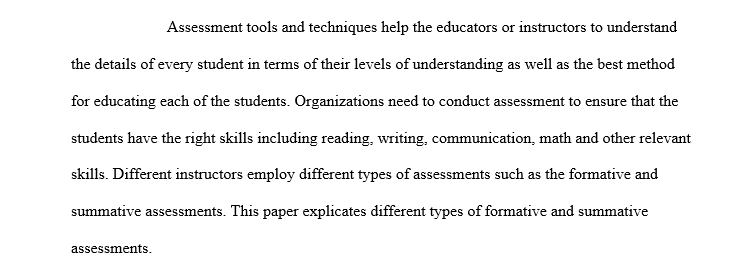Describe four different types of both formative and summative assessments
PROJECT PLAN
Beginning this week, you will start creating a project plan that will include creating an assessment program for your organization. In no more than six pages, address the following points:
Describe four different types of both formative and summative assessments that could be used in your organization.
Describe the reasoning and purpose behind your choices.
Describe what part the learner will play in each assessment.
Include an introduction, section headings for each type of assessment, and a conclusion.
Support your statements with evidence from the Required Studies and your research. Consider what will be necessary to carry out this Project Plan over the coming weeks.
Click here for information on course rubrics.
ASSESSMENT FOR LEARNING: CONTRASTING DIFFERENT TYPES OF ASSESSMENT AND THEIR USES
It is important, as educators, that there is a clear understanding with respect to assessment and learning. As discussed in Weeks 1 and 2, assessment is a “formal attempt to determine a student’s status with respect to educational variables of interest” (Popham, 2014, p. 8).
With that statement as a guiding thought, what exactly should a facilitator test? Is an assessment different than a test? Is an evaluation a test?
You may already be familiar with formative and summative assessments and their use in organizations. However, recent studies indicate that other means of assessing could benefit outcomes and help fulfill the mission of an organization. This week, we will explore many different types of assessments and their uses. When used properly, these assessments not only improve learning but also create a new excitement about progress.
This week we will look beyond the test or quiz using paper and pencil and look at different ways
of testing. In the realm of educational assessment, federal laws tend to rule (Popham, 2017). Here the term assessment is used most often. With Popham’s (2014) definition of assessment, we put to use our terms variableand reliable from Week 2 and envisioned an assessment system that would make absolutely certain that all of our valued learning targets are clear and appropriate for the intended learners (Stiggins, 2017, p. 7).
In Week 1, we determined the traditional reasons that facilitators assess stakeholders:
To diagnose stakeholder’s strengths and weaknesses;
To monitor stakeholder’s progress;
To assign a score to stakeholders; and,
To determine instructional effectiveness (Popham, 2017).
As 21st century educators, we also need to know more about assessing students in our classroom – specifically,
Constructing your own assessment instruments;
Using assessment instruments constructed by others; and,
Planning instruction based on instructionally illuminating assessments (Popham, 2017).
References
Popham, J. (2014). Classroom assessment: What teachers need to know (7th ed.). Boston, MA: Pearson.
Popham, W. J. (2017). Classroom assessment: What teachers need to know (8th ed.) Upper Saddle River, NJ: Pearson Education, Inc.
Stiggins, R. (2017). The perfect assessment system. Alexandria, VA: ASCD.
REQUIRED STUDIES
The following materials are required studies for this week. Complete these studies, take note of quotable sections at the beginning of the week and save these materials for future use.
Assessment for Education (Klenowski & Wyatt-Smith, 2013)
Chapter 8: Assessment and Digital Literacies
Classroom Assessment: What Teachers Need to Know (Popham, 2017)
Chapter 6: Selected-Response Tests
Chapter 7: Constructed-Response Tests
Chapter 8: Performance Assessment
Chapter 9: Portfolio Assessment
Chapter 12: Formative Assessment
Read
Beyond the Core: Assessing Authentic 21st Century Skills (Greenstein, 2012) [Web page]
View
Multiple Intelligences Thrive in Smartville (Edutopia, 2010) [Video] [Closed captioned]
Born to Learn (Born to Learn, 2011) [Video] [Closed captioned]
Review
Intelligence Reframed: Multiple Intelligences for the 21st Century (Gardner & McConaghy, 2000) [Web page]
Answer preview to describe four different types of both formative and summative assessments
APA
1592 words


